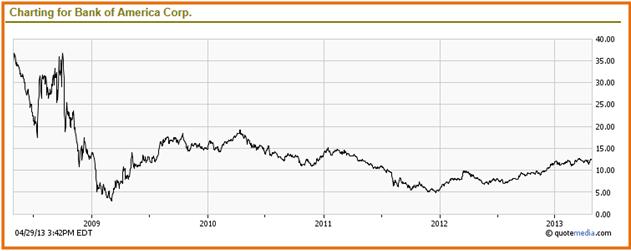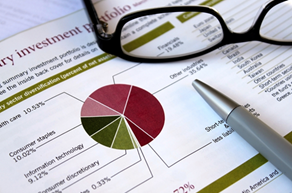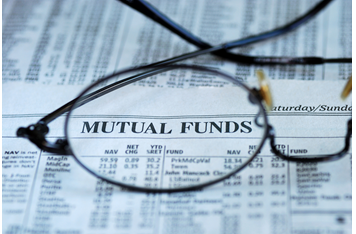Proof of Performance
When BAC reported financial results for Q1 2013, it reported Net Income of $2.6B, which was a significant surge from the $653M reported a year earlier. Diluted EPS came in at $0.20/share, a healthy improvement from the $0.03 reported in the first quarter of 2012.
And Net Income was not simply a function of the $1B cost cutting that the bank achieved either, although that certainly helped. Revenue increased 5%, up from $22.5B in Q1 2012 to $23.7B in the most recent quarter. As BAC's Press Release indicates: "Relative to the same period a year ago, the results for the first quarter of 2013 were driven by increased brokerage income, higher investment banking fees, and improved credit quality across all major portfolios."
More good news followed. At the end of Q1 2013, BAC's internally estimated Basel III Tier 1 common ratio now stands at a healthy 9.42%. That's nearly a percentage point over and above the post-bailout government stipulated 8.5% needed of BAC as part of being a "systemically" significant institution.
Add to that the improving U.S. economy, the rebound in the U.S. housing industry, and the increase in consumer confidence, and BAC investors have better days to look forward to. The doom and gloom that was predicted for Europe (the exit of Greece from the Euro Zone, the imminent collapse of the Euro, the disintegration of the Spanish and Italian economies) have not come to pass either, which means BAC global operations are poised for a rebound as well, albeit a gradually improving one.
And for the next quarter ending June 2013, analysts expect the bank to rake in an additional $22.56B in revenues, with EPS estimated at $0.25/share.
5 Years Ago
In the world of investment and financial planning, the year 2008, although now over 5 years back, is still fresh in the minds of some investors. Next to Citigroup (C), BAC was the largest recipient of government money, to the tune of over $20B, along with guarantees of protection against losses emanating from toxic assets to the tune of over $100B more. This was over and above the approximately $25B taxpayer money that BAC received the previous October under the Treasury Department's Troubled Asset Relief Program (TARP) program. These huge amounts of taxpayer bailout were the result of BAC's then recent acquisition of the brokerage firm Merrill Lynch & Co.
The bailouts were announced to the general public on Friday Jan 16th 2009, when BAC's stock closed at $7.04, almost 81% down from when it traded at close of business on May 2008 ($32.72). But there was more bad news to follow. Over the ensuing period, investors became privy to additional information about the toxicity of the Merrill Lynch deal for BAC. Panic selling ensued, and by March 9th 2009, BAC shares were trading at a 17-year low of $3.69.
Root Cause Analysis
In the wake of this dire financial strait, analysts and investors questioned the wisdom behind BAC's $19.4B acquisition of Merrill Lynch, and the equally stunning $2.5B deal to acquire Countrywide Financial Corp. Decisions that put heavy strains on the bank's finances and pushed its balance sheet into "stress mode".
[newsletter2][/newsletter2]
But then came the housing crises in the U.S., and with heavy exposure to the mortgage industry, both commercial and residential, BAC faced even more headwinds. The recent acquisitions, which were then being touted as a coup, added even more stress to the bank's financial situation, primarily through massive exposure to unsecured or severely under secured mortgages.
But there was even more bad news to follow. The recession in the U.S. took firm hold on the economy, dragging it down. And with that also came news of a global recession, particularly in Europe. BAC had significant exposure to consumer credit, including credit card loans, which took a big hit. A perfect storm was brewing, and investors onboard the SS BAC were drifting down into a terrible spiralling vortex of sinking share prices.
And as the recession worsened, the bank's investment financing and wealth management businesses suffered. Businesses were not willing to take loans (from BAC and its peers) to make investments into a flagging economy, preferring to wait on the sidelines until the clouds cleared. And as economic conditions worsened, high-net-worth individuals and groups held off handing their fortunes to the bank's investment managers.
The Road to Recovery
The bailout of the former banking giant did not come without strings attached though. For one, the Board no longer had the authority to raise or declare dividends – that power wrested by the government. Additional bitter medicine followed: The bank had to get its house in order and boost its capital reserves so that they could deal with the mountain of bad debts on the balance sheet. While these stringent conditions forestalled major collapse and disintegration of the bank, there was much more needed to be done to put it on the road to recovery.
Over the next few years Brian Moynihan, who took over the reins in 2010 as Chief Executive Officer of BAC, and his team took a long and hard look at the problem and decided to make some tough choices. For starters, thousands of jobs were cut as part of a major restructuring plan. By September of 2012, the former giant had paired down its headcount to around 260,000 – the lowest levels since 2008.
But even more repair work followed. As part of the restructuring, and keeping the new global realities in mind, the Executive team shut down another 200 branches globally. These were in addition to the 178 that were shuttered back in 2011. Closures and layoffs came from right across BAC's service areas – commercial banking, retail banking, investment banking, credit card services and insurance operations. Anything that the Exec team believed did not add business or shareholder value was on the chopping block.
The resulting effort saw BAC shed off over 7% of its total asset holdings, bringing down the value of its balance sheet from approximately $2.33T to a humbling $2.16T.
The balance sheet "fixers" were not done yet! The management team took aim at the faulty mortgages and loans advanced by Freddie Mac and Fannie Mae, and reach deals with aggrieved parties to settle their issues "amicably" and without protracted legal wrangling. The settlement proposed with Bank of New York Mellon (BK), a large component of its outstanding private-label obligations, further props up the balance sheet by reducing the level of new claims against BAC. By early 2013, BAC had settled almost $19B of its balance sheet "mess".
Best of luck in your Investing,
In the meantime, do let us know if you have any questions.
MarketConsensus Stock Analysis Desk
Stay in Touch:
Facebook (Like Us on Facebook)
Google + (Connect with Us on Google+)
Twitter (Follow Us on Twitter)
Contact Us (Questions/Comments)
————————————————————————————————-
[related1][/related1]






